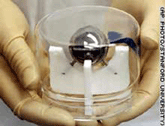
« PREVIOUS ENTRY
Catty: The chatbot with a Google brain
NEXT ENTRY »
Robot jesus

Gravity Probe B is finally getting ready to launch — after 45 years. What, might you ask, is Gravity Probe B? Basically, it’s a really weird experiment intended to prove some aspects of Einstein’s theory of relativity.
One of Einstein’s predictions is that if you put an object in orbit around the earth, after a long enough time zipping around space-time, it would begin to experience a different orientation than the same object would if left stationary on Earth. Essentially, it’d have a different sense of “north”. It’s an effect called “frame dragging,” which you can now officially use to trump the pseuds at the next cocktail party.
The problem is, at satellite speed — which is way, way slower than the speed of light — the effect of frame dragging is incredibly minute. The shift in perspective for an object would be 1/3 of a milli-arc-second a year — which is, like, well, just kind of incredibly tiny. (It’s what a piece of hair would look like if you peered at it from 20 miles away.) So how do you measure such a tiny shift in degree?
With Gravity Probe B! It’s essentially an enormous flying thermos that contains four ping-pong-sized balls of quartz, which are the roundest things ever made by humans. They’re so smooth that the only thing rounder is a neutron star. As a cool story about Gravity Probe B puts it:
That’s equivalent to the Earth’s surface being polished so round that mountain peaks and ocean trenches are within 5 meters (16 ft) of the same level.
I'm Clive Thompson, the author of Smarter Than You Think: How Technology is Changing Our Minds for the Better (Penguin Press). You can order the book now at Amazon, Barnes and Noble, Powells, Indiebound, or through your local bookstore! I'm also a contributing writer for the New York Times Magazine and a columnist for Wired magazine. Email is here or ping me via the antiquated form of AOL IM (pomeranian99).

ECHO
Erik Weissengruber
Vespaboy
Terri Senft
Tom Igoe
El Rey Del Art
Morgan Noel
Maura Johnston
Cori Eckert
Heather Gold
Andrew Hearst
Chris Allbritton
Bret Dawson
Michele Tepper
Sharyn November
Gail Jaitin
Barnaby Marshall
Frankly, I'd Rather Not
The Shifted Librarian
Ryan Bigge
Nick Denton
Howard Sherman's Nuggets
Serial Deviant
Ellen McDermott
Jeff Liu
Marc Kelsey
Chris Shieh
Iron Monkey
Diversions
Rob Toole
Donut Rock City
Ross Judson
Idle Words
J-Walk Blog
The Antic Muse
Tribblescape
Little Things
Jeff Heer
Abstract Dynamics
Snark Market
Plastic Bag
Sensory Impact
Incoming Signals
MemeFirst
MemoryCard
Majikthise
Ludonauts
Boing Boing
Slashdot
Atrios
Smart Mobs
Plastic
Ludology.org
The Feature
Gizmodo
game girl
Mindjack
Techdirt Wireless News
Corante Gaming blog
Corante Social Software blog
ECHO
SciTech Daily
Arts and Letters Daily
Textually.org
BlogPulse
Robots.net
Alan Reiter's Wireless Data Weblog
Brad DeLong
Viral Marketing Blog
Gameblogs
Slashdot Games